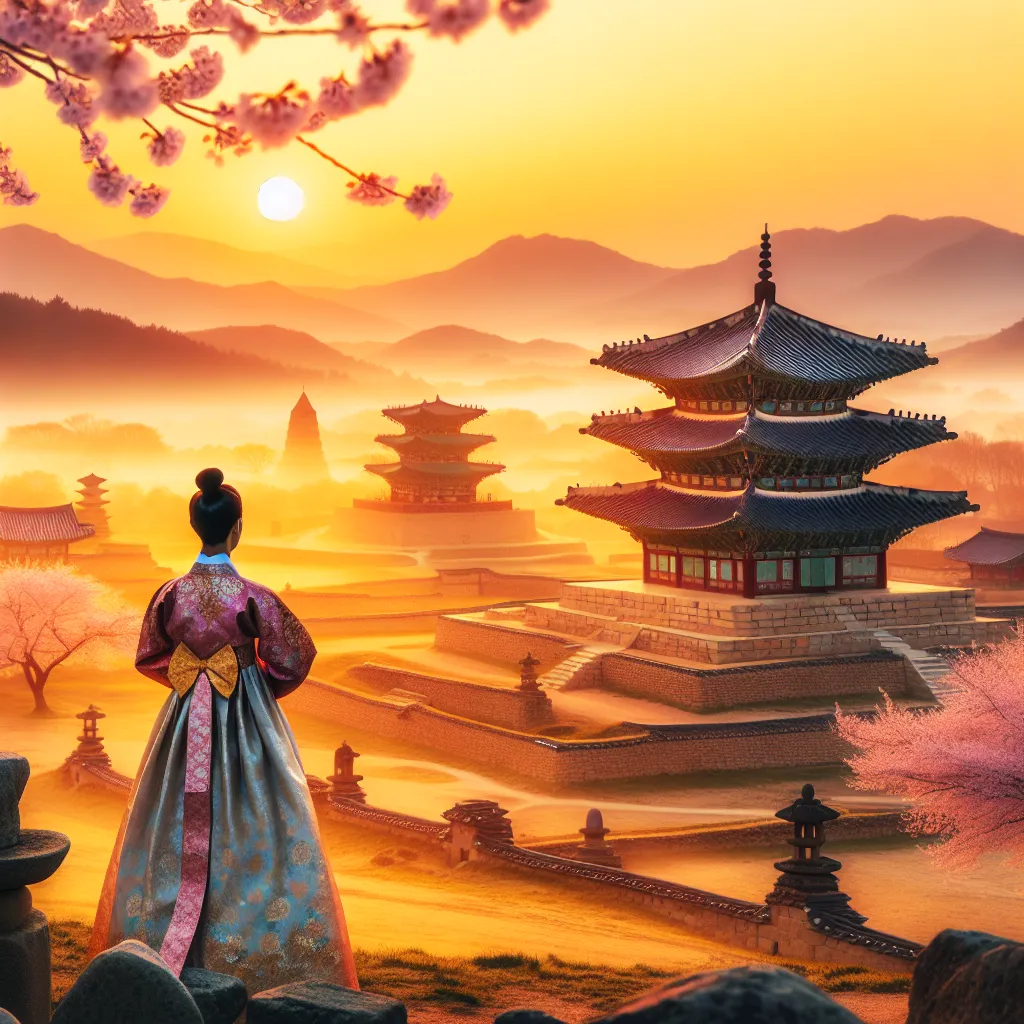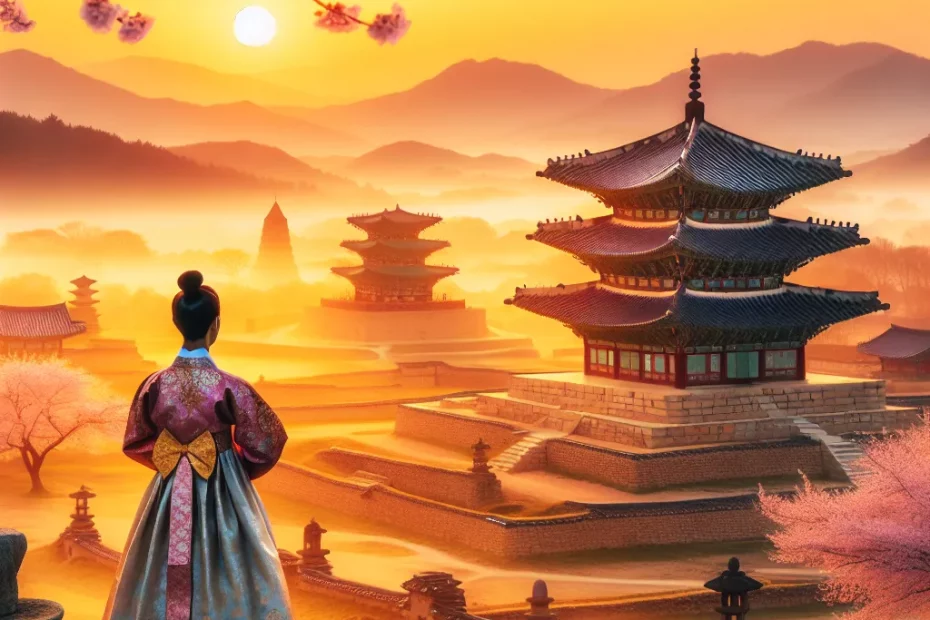Gyeongju, the ancient capital city of Korea, holds a wealth of historical treasures waiting to be explored. From the remnants of the Silla Dynasty to the UNESCO World Heritage Sites scattered throughout the city, Gyeongju offers a glimpse into Korea’s rich past. As we delve into the mysteries of this culturally significant city, we uncover stories of power, innovation, and artistic brilliance. Join me on a journey through time as we unravel the secrets of Gyeongju, a place where tradition and modernity harmoniously coexist.

The Historical Significance of Gyeongju
Welcome to a journey through time as we unveil the mysteries of Gyeongju, Korea’s ancient capital city! 🏛️
Gyeongju: The “Museum Without Walls”
Gyeongju, often referred to as the “Museum Without Walls,” holds a special place in Korean history and culture. With a history spanning over a thousand years, this city is a treasure trove of archaeological wonders and historical landmarks. 🌟
The Ancient Capital of the Silla Kingdom
As the capital of the ancient Silla Kingdom, Gyeongju flourished from the 1st century BCE to the 10th century CE, leaving behind a rich legacy that continues to captivate historians, archaeologists, and visitors alike. 🏰
Bulguksa Temple: A UNESCO World Heritage Site
One of the most iconic sites in Gyeongju is the Bulguksa Temple, a UNESCO World Heritage site that dates back to the 8th century. This magnificent temple complex, with its intricate architecture and serene surroundings, is a testament to the advanced craftsmanship and spiritual devotion of the Silla people. 🕍
Seokguram Grotto: Masterpiece of Korean Buddhist Art
Another must-visit destination in Gyeongju is the Seokguram Grotto, home to a stunning granite Buddha statue that is considered a masterpiece of Korean Buddhist art. The grotto, carved into the mountainside, offers a glimpse into the religious practices and artistic achievements of the Silla Kingdom. 🌄
Cheomseongdae Observatory: Ancient Astronomical Wonder
In addition to its architectural wonders, Gyeongju is home to the Cheomseongdae Observatory, the oldest existing astronomical observatory in East Asia. Built in the 7th century, this observatory reflects the Silla people’s fascination with the stars and their advanced knowledge of astronomy. 🔭
Gyeongju National Museum: Gateway to the Past
Gyeongju‘s historical significance extends beyond its tangible heritage. The Gyeongju National Museum houses a vast collection of artifacts that provide insights into the daily life, art, and culture of the Silla Kingdom. From exquisite gold crowns to delicate pottery, these artifacts offer a glimpse into a bygone era. 🏺
UNESCO World Heritage Site
Gyeongju‘s historical significance extends beyond its tangible heritage. The city’s inclusion on the UNESCO World Heritage list underscores its importance as a cultural site of global significance. By preserving and showcasing Gyeongju‘s rich history, we not only honor the legacy of the Silla Kingdom but also celebrate the enduring spirit of Korean civilization. 🌏
So, as you explore the ancient streets of Gyeongju and marvel at its wonders, remember that you are walking in the footsteps of kings, scholars, and artisans who shaped the course of Korean history. Let the echoes of the past guide you through this enchanting city and immerse yourself in the historical significance of Gyeongju. 🌿
Experience the magic of Gyeongju, where history comes alive and the legacy of the past continues to inspire and awe visitors from around the world. 🌟
The Treasures of Gyeongju’s Silla Dynasty
Welcome to the ancient capital city of Korea, Gyeongju, where the remnants of the glorious Silla Dynasty still stand tall, echoing the tales of a bygone era. The treasures of Gyeongju’s Silla Dynasty are not merely artifacts; they are windows to a civilization that thrived over a thousand years ago. 🏛✨
Exploring Bulguksa Temple
As you wander through the historic sites of Gyeongju, you will encounter the Bulguksa Temple, a UNESCO World Heritage Site that showcases the exquisite architectural prowess of the Silla Dynasty. The intricate carvings on the temple walls tell stories of devotion and artistic excellence that defined the era. 🕌🎨
Discovering Seokguram Grotto
Venture further to the Seokguram Grotto, a marvel of ancient engineering nestled in the hills overlooking Gyeongju. This sacred site houses a magnificent stone Buddha, a symbol of spiritual enlightenment and a testament to the Silla Dynasty’s religious legacy. 🗿🌿
Exploring Cheomseongdae Observatory
But the treasures of Gyeongju go beyond temples and grottos. Explore the Cheomseongdae Observatory, an ancient astronomical observatory that reflects the Silla Dynasty’s advanced knowledge of the cosmos. The alignment of the observatory with the celestial bodies is a testament to the scientific achievements of the era. 🌌🔭
Visiting Royal Tombs of Gyeongju
Don’t miss the opportunity to visit the Royal Tombs of Gyeongju, where the rulers of the Silla Dynasty rest in grandeur. The intricate artwork adorning the tombs and the treasures buried within speak volumes about the wealth and sophistication of Silla society. 💎⚱
As you immerse yourself in the treasures of Gyeongju’s Silla Dynasty, you will be transported back in time to an era of artistic brilliance, spiritual enlightenment, and scientific advancement. Each artifact, each site, whispers a story of a civilization that left an indelible mark on Korean history. 📜🌟
So come, explore the treasures of Gyeongju, and unravel the mysteries of Korea’s ancient capital city. The legacy of the Silla Dynasty awaits you, eager to share its secrets and wonders. 🇰🇷🏰
Exploring Gyeongju’s UNESCO World Heritage Sites
Welcome to the ancient city of Gyeongju, a place where history comes alive with every step you take! Gyeongju, once the capital of the Silla Kingdom, is a treasure trove of UNESCO World Heritage Sites that offer a glimpse into Korea’s rich past. Let’s embark on a journey to uncover the mysteries and wonders of this historic city! 🏛️🌟
The Majestic Bulguksa Temple
As you wander through the streets of Gyeongju, you will encounter the majestic Bulguksa Temple, a true masterpiece of Buddhist art and architecture. This temple, built in the 8th century, is a symbol of Korea’s cultural heritage and spiritual devotion. The intricate carvings, graceful pagodas, and serene gardens of Bulguksa will leave you in awe of the ancient craftsmanship and dedication that went into its creation. 🕍✨
The Mystical Seokguram Grotto
Not far from Bulguksa lies the Seokguram Grotto, a mystical sanctuary nestled in the hills overlooking the city. This grotto houses a magnificent granite Buddha statue, considered a pinnacle of Buddhist art in East Asia. The serene atmosphere and spiritual energy of Seokguram make it a must-visit site for those seeking enlightenment and inner peace. 🌿🙏
The Royal Tombs of Tumuli Park
Venture further into Gyeongju and you will discover the royal tombs of the Silla kings at Tumuli Park. These grass-covered mounds hold the remains of ancient rulers and are a testament to the grandeur and sophistication of the Silla Dynasty. Walking among the tumuli, you can almost feel the echoes of the past whispering tales of power and legacy. 🏰👑
The Historic Yangdong Village
One cannot explore Gyeongju without visiting the historic site of Yangdong Village, a traditional Korean village frozen in time. This well-preserved village showcases the elegant architecture and lifestyle of the Joseon period, offering a glimpse into the daily lives of the noble class. Strolling through the narrow alleyways and tiled-roof houses of Yangdong Village is like stepping back in time to experience the charm of old Korea. 🏡🌳
The Picturesque Anapji Pond
Gyeongju is not just a city of ancient relics, but also a place of natural beauty. Take a leisurely stroll along the picturesque Anapji Pond, where the moonlight once reflected the glory of the Silla kings’ banquets. The tranquil waters, surrounded by lush gardens and pavilions, create a serene ambiance that is perfect for contemplation and relaxation. 🌌🌿
In conclusion, Gyeongju’s UNESCO World Heritage Sites offer a fascinating glimpse into Korea’s glorious past, where history, art, and nature converge to create a truly enchanting experience. So pack your bags, put on your walking shoes, and get ready to explore the wonders of Gyeongju – a journey you won’t soon forget! 🌏🚶♂️
Modern-Day Gyeongju: Balancing Tradition and Development
Nestled in the southeastern part of South Korea, Gyeongju stands as a testament to the country’s rich history and cultural heritage. Known as the ancient capital of the Silla Kingdom, this city seamlessly blends its historical significance with modern-day developments, creating a unique tapestry of tradition and progress.
Steeped in over 2,000 years of history
Gyeongju boasts a plethora of archaeological sites, including the UNESCO World Heritage-listed Bulguksa Temple and Seokguram Grotto. These ancient relics serve as a reminder of Korea’s glorious past and attract visitors from around the globe, eager to explore the mysteries of this once-thriving capital city.
Embracing modernity while preserving cultural identity
Despite its deep-rooted history, Gyeongju has successfully managed to embrace modernity while preserving its cultural identity. The city’s urban landscape is dotted with traditional hanok houses, providing a glimpse into the past, while contemporary buildings and infrastructure symbolize its progressive outlook towards the future.
Harmonious blend of natural beauty and cultural heritage
Surrounded by picturesque mountains and serene countryside, Gyeongju offers a harmonious blend of natural beauty and cultural heritage. Visitors can wander through lush parks, visit ancient tombs, or simply soak in the tranquil atmosphere that permeates the city, creating a sense of timelessness that transcends generations.
The annual Gyeongju Cherry Blossom Festival
The annual Gyeongju Cherry Blossom Festival is a vibrant celebration of nature’s beauty, attracting thousands of tourists each year. The blooming cherry blossoms serve as a stunning backdrop to traditional performances, cultural exhibitions, and local delicacies, showcasing the city’s commitment to preserving its heritage in a modern context.
Rapid development and historical legacy
In recent years, Gyeongju has also seen rapid development in various sectors, including technology, tourism, and education. The city’s strategic location and robust infrastructure have made it a hub for innovation and growth, attracting businesses and investors looking to capitalize on its potential while maintaining a delicate balance with its historical legacy.
Honoring the past and shaping the future
As Gyeongju continues to evolve and adapt to the demands of the modern world, it remains steadfast in its commitment to honoring the past and shaping a future that respects both tradition and development. This delicate balance is what sets Gyeongju apart as a city that cherishes its roots while embracing the possibilities of tomorrow, making it a truly remarkable destination for travelers and historians alike.
In conclusion, Gyeongju serves as a living testament to the enduring spirit of Korea, where tradition and development coexist in perfect harmony, creating a city that is as dynamic as it is timeless. Visit Gyeongju and immerse yourself in a world where the past meets the future, and history comes alive in every corner.
In conclusion, Gyeongju stands as a testament to Korea’s rich history and cultural heritage. The city’s ancient roots, embodied by its UNESCO World Heritage Sites and Silla Dynasty treasures, offer a glimpse into the past that continues to inspire awe and wonder. As modern-day Gyeongju strives to balance tradition with development, it serves as a living museum where the past and present harmoniously coexist, inviting visitors to explore and appreciate the mysteries of this ancient capital city.
